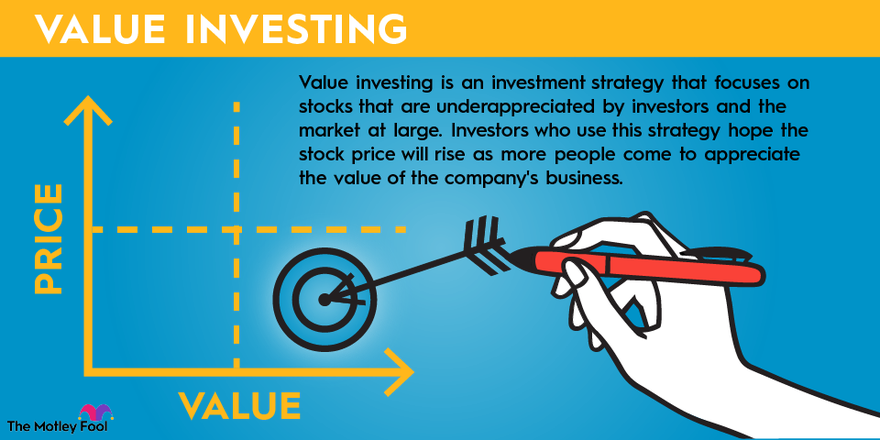What is value investing?
Value investing is an investment strategy that focuses on stocks that are underappreciated by investors and the market at large. The stocks that value investors seek typically look cheap compared to the underlying revenue and earnings from their businesses. Investors who use the value investing strategy hope the stock price will rise as more people come to appreciate the true intrinsic value of the company's fundamental business.
The greater the difference between the intrinsic value and the current stock price, the greater the margin of safety for value investors looking for investment opportunities. Because not every value stock will turn its business around successfully, that margin of safety is important for value investors to minimize their losses when they're wrong about a company.

What makes a great value stock?
The defining characteristic of a value stock is that it has an inexpensive valuation compared to the value of its assets or its key financial metrics (such as revenue, earnings, or cash flow). However, the best value stocks also have other attractive characteristics that make them appealing to investors who use value investing strategies:
- Well-established businesses with long histories of success
- Consistent profitability
- Stable revenue streams without huge amounts of growth but typically also without big sales contractions
- Dividend payments, although paying a dividend isn't a requirement to qualify as a value stock
However, it's important to understand that a company with all of these attributes isn't necessarily a great value stock. Sometimes a stock only appears to be a good value for investors but is actually a value trap. Value traps can continue to suffer share price declines even when their stocks seem attractive.
Why invest in value stocks?
Everyone likes a bargain, and because value investing seeks stocks selling at a discount to their intrinsic value, the investment strategy appeals to those who like to get good deals. All it takes to make money with a value stock is for enough other investors to realize there's a mismatch between the stock's current price and what it's actually worth. Once that happens, the share price should go up to reflect the higher intrinsic value. Then those who bought in at a discount will get their profit.
Furthermore, many investors like the margin of safety provided by a stock that's purchased for less than what it's inherently worth. There's no guarantee the stock price won't fall further, but it does make additional share-price declines less probable and less dramatic.
For those who see themselves as defensive investors without much tolerance for risk, a good value stock can provide both protection against losing money and the potential to cash in once the stock market recognizes the stock's true value.
Value investing can require patience because it often takes a long time for a value stock to get repriced at a more appropriate and higher level. For those willing to wait, however, the returns can be quite sizable.
How to find value stocks
Value investing requires a lot of research. You'll have to do your homework by going through many out-of-favor stocks to measure a company's intrinsic value and compare that to its current stock price. You'll often have to look at dozens of companies before you find a single one that's a true value stock.
That's enough to intimidate many would-be value investors, but there are some tricks you can use to identify good value stocks. By fully understanding the many ways to value a company and assess its business prospects, you can weed out inappropriate stocks more quickly to concentrate on your best candidates.
Read More: How to Value a Stock
Avoiding value traps
A value trap is a stock that looks cheap but actually isn't. A couple of situations often produce value traps that value investors should watch out for:
- Stocks in cyclical industries such as manufacturing and construction often see their earnings rise substantially during boom times, only to watch much of them disappear when industry conditions cool off. When investors see a possible bust coming for a stock, its valuation will look very inexpensive compared to recent earnings -- but much less so once earnings fall during the weaker part of the business cycle.
- Stocks in areas that emphasize intellectual property are prone to become value traps. For instance, if a drug company has a high-selling treatment but is losing patent protection for it in the near future, much of its profits can disappear quickly. The same is true of a tech company that's the first mover in a new industry but lacks the ability to protect itself against competition.
To avoid value traps, remember that the future of a company is more important than its past when valuing a stock. If you focus on a company's prospects for sales and earnings growth in the months and years to come, you'll be more likely to find true value stocks.
Is value investing right for you?
If your primary investing goal is to keep your risk of permanent losses to an absolute minimum while increasing your odds of generating positive returns, you're probably a value investor at heart.
By contrast, those who prefer to follow the hottest companies in the market often find value investing downright boring since growth opportunities for value companies tend to be tepid at best.
Value investors have to be resilient as well. The value-finding process eliminates far more stocks than it uncovers, and it can be a highly frustrating way to invest during a bull market.
Many stocks you cross off your buy list during your search will keep rising in value in bull markets despite the fact that you found them too expensive to begin with. But the payback comes when the bull market ends because the margin of safety from value stocks can make it much easier to ride out a downturn.
Read more: Best Value Stock ETFs
Growth vs. value investing
If value investing doesn't match up well with your particular investing style, you might consider growth investing. Growth investing looks more at the prospects a business has to see its revenue and net income rise dramatically over time, with an emphasis on the fastest-growing companies in the market.
Growth investors don't care nearly as much about intrinsic value as value investors do, instead counting on extraordinary business growth to justify the higher valuations investors have to pay to buy shares.
Read More: Growth vs. Value Investing
How did value investing get started?
Value investing has evolved over time. Its roots are in the Great Depression and its aftermath when the strategy's focus was purely on buying companies whose assets were worth more than the stock traded for. That was largely because many companies were going out of business during that time, so opportunities to buy stocks for less than the value of assets had direct implications when a company liquidated.
Since then, though, value investing has grown into more fundamental analysis of a company's cash flows and earnings. Value investors also look at a company's competitive advantages to assess whether a stock is deeply discounted.
Who are the two most famous value investors?
Benjamin Graham is generally regarded as the creator of value investing. Graham's Security Analysis, published in 1934, and The Intelligent Investor, published in 1949, established the precepts of value investing, including the concept of intrinsic value and establishing a margin of safety.
Besides those two invaluable tomes Graham authored, his most lasting contribution to value investing was his role in setting the stage for legendary investor Warren Buffett. Buffett studied under Graham at Columbia University and worked for a short time at Graham's firm.
As the CEO of Berkshire Hathaway (BRK.A -0.59%) (BRK.B -0.74%), Buffett is perhaps the best-known value investor. Buffett cut his teeth in value investing in his early 20s and used the strategy to deliver immense returns for investors in the 1960s before taking control of Berkshire in the 1970s.
However, the influence of Charlie Munger, Berkshire's vice chairman and Buffett's investing partner for many decades, along with Buffett's evolution as an investor, has changed Buffett's strategy. Instead of purely buying undervalued assets, Buffett shifted to identifying high-quality businesses at reasonable values.
This famous Buffett quote best describes why his thinking on value has changed over the years: "Better to buy a wonderful business at a fair price than a fair business at a wonderful price."
Let value investing help you
The most important thing to understand is that value investing requires a long-term mindset. As economist John Maynard Keynes said, "The market can remain irrational longer than you can remain solvent." The lesson is that, while occasionally one's timing is lucky and an investment pays off very quickly, even a value-focused strategy doesn't guarantee quick gains. Mr. Market doesn't always "realize" very quickly that it was wrong about a stock or that it undervalued an asset.
Value investing strategies take time to follow, but the time and effort you spend are worth it. Understanding and applying the value investing concepts Graham wrote about almost 90 years ago -- and that Buffett and others have added to and improved upon since -- will make you a better investor with better chances of being successful in choosing great stocks.









